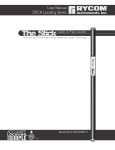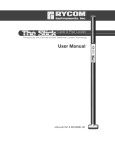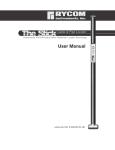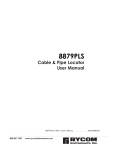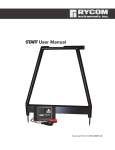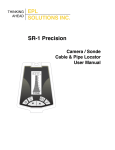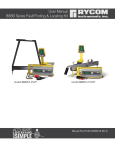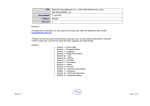Download Manual - RYCOM Instruments, Inc.
Transcript
8873 Pathfinder v3 Locator User Manual Manual Part # 030-00100-00 Rev A Table of Contents General Information Introduction . . . . . . . . . . . . . . . . . . . . . . . . . . . . . . . . . . . . . . . . . . . . . . . . 2 Prepare for Use . . . . . . . . . . . . . . . . . . . . . . . . . . . . . . . . . . . . . . . . . . . . . 2 Receiver Operation . . . . . . . . . . . . . . . . . . . . . . . . . . . . . . . . . . . . . . . 4-5 Absolute Signal Strength . . . . . . . . . . . . . . . . . . . . . . . . . . . . . . . . . . . . . Gain Change Indication . . . . . . . . . . . . . . . . . . . . . . . . . . . . . . . . . . . . . Passive Locating . . . . . . . . . . . . . . . . . . . . . . . . . . . . . . . . . . . . . . . . . . . . Push Button Digital Depth . . . . . . . . . . . . . . . . . . . . . . . . . . . . . . . . . . . . 5 5 5 5 Transmitter Operation . . . . . . . . . . . . . . . . . . . . . . . . . . . . . . . . . . . . . . . 7 Frequency . . . . . . . . . . . . . . . . . . . . . . . . . . . . . . . . . . . . . . . . . . . . . . . . . Loading . . . . . . . . . . . . . . . . . . . . . . . . . . . . . . . . . . . . . . . . . . . . . . . . . . . Output Level Control . . . . . . . . . . . . . . . . . . . . . . . . . . . . . . . . . . . . . . . . Low Battery . . . . . . . . . . . . . . . . . . . . . . . . . . . . . . . . . . . . . . . . . . . . . . . . 7 7 7 7 Line Locating Signal Application Direct Connection . . . . . . . . . . . . . . . . . . . . . . . . . . 7 Signal Application Coupler Induction . . . . . . . . . . . . . . . . . . . . . . . . . . 7 Signal Application Transmitter Induction . . . . . . . . . . . . . . . . . . . . . . . . 8 Locating Buried Conductors . . . . . . . . . . . . . . . . . . . . . . . . . . . . . . . . . 10 Sonde Locating Locating the Sonde . . . . . . . . . . . . . . . . . . . . . . . . . . . . . . . . . . . . . 11-13 Sonde Depth . . . . . . . . . . . . . . . . . . . . . . . . . . . . . . . . . . . . . . . . . . . . . . 13 Specifications . . . . . . . . . . . . . . . . . . . . . . . . . . . . . . . . . . . . . . . . . . 14-15 Factory Service . . . . . . . . . . . . . . . . . . . . . . . . . . . . . . . . . . . . . . . . . . . . 16 Warranty . . . . . . . . . . . . . . . . . . . . . . . . . . . . . . . . . . . . . . . . . . . . . . . . . . 16 800.851.7347 www.rycominstruments.com 1 Introduction Congratulations on the purchase of your new 8873 Pathfinder Locator. The 8873 Locator is specially designed to detect sondes and camera systems, and the unit is capable of detecting buried power cables, CATV cables, gas and water pipes, sewer lines, telephone cables, fiber optic cables with sheath. For Sonde locating & camera head locating a signal is generated by the sonde or camera head and the receiver detects the signal giving the user proximity cue to determine its location. The Transmitter emits a signal that is conducted or coupled to a conductors. The Receiver detects the signal. You can locate the relative position of the buried conductor by following the tracing signal. ! WARNING Electric shock hazard: • Tool is designed to detect electromagnetic field emitted from Camera Sondes and buried metallic utilities. There are buried cables, pipes, and utilities this instrument CANNOT detect. • LOCATING is not an exact science. The only certain way to be sure of the existence, location, or depth of buried utilities is to carefully expose (dig up) the utility. • De-energize any circuits in or around the work area. • Do not expose tool to rain or moisture. • Use tool only for intended purpose as described in this manual Failure to observe these warnings could result in severe injury or death. DISCLAIMER OF LIABILITY RYCOM INSTRUMENTS, INC SHALL NOT BE LIABLE TO DISTRIBUTOR, RESELLER, OR ANY OTHER PERSON FOR ANY INCIDENTAL, INDIRECT, SPECIAL, EXEMPLARY OR CONSEQUENTIAL DAMAGES, OR INJURY OF ANY TYPE WHATSOEVER, AND CAUSED DIRECTLY OR INDIRECTLY BY PRODUCTS SOLD OR SUPPLIED BY RYCOM INSTRUMENTS, INC. Part Numbers 8873 Pathfinder Locator Receiver Transmitter (C-Cell) User’s Manual 4" Coupler (Optional) Headset (Optional) Prepare for Use Unpack your new 8873 Locator . Make sure there is no shipping damage and all the parts are included. Locate the battery compartment on the back of the “head” of the Receiver & Transmitter. Open the compartment using a phillips screwdriver. Install the six Duracell® “C” batteries as marked in the Receiver and eight "C" cells in the Transmitter. Note: For longer battery life and reliable operation under adverse conditions, use only Duracell® alkaline batteries. 800.851.7347 www.rycominstruments.com 2 Changing Operating Program & Frequency Sets Note: This setup procedure is not required unless the user desires to change factory settings. The 8873 operating programs and frequency sets are user programmable and can be changed at anytime through a quick selection process. To select the desired frequency set on the RECEIVER: • Press, and hold depressed, the Power On Button. • Pressing the Gain Down Button will toggle through available configurations. The 8873 Receiver offers the following modes: • 512 - offers 512Hz Sonde locating mode only • CAL- selected for calibration of system (for authorized use only) • U3 - offers 512Hz, 640Hz, 8kHz & 33kHz in Sonde mode and offers user selection of any of the following line locate frequencies: Passive 50Hz & 60Hz, Passive RF, 512Hz, 640Hz, 8kHz, 9kHz, 33kHz, 65kHz, 82kHz, 200kHz, 478kHz U3 mode. • To select available frequencies, toggle to the • Without releasing the Power On Button, short press the Frequency button to toggle to the desired frequency. • Select the displayed frequency by holding depressed the Frequency button for a long press (2 seconds). At the top of the LCD the count of frequencies selected will tally up one each time a frequency is selected. • Short press the Frequency Button to toggle to the next desired frequency. • Releasing the Power On Button will exit the setup menu and save the selected frequencies for availability during normal operation. To select the desired frequency set: on the TRANSMITTER • Press and hold depressed the Power On Button. • Pressing the Information Button will toggle through available configurations. Repeat pressing until U3 is displayed in the Frequency Indicator section of the LCD. • Press and hold depressed the Power On Button. • Without releasing the Power On Button, press the Frequency Button to toggle through the available frequencies. • To select and store the desired frequency press the Information Button. The count of the selected frequency will be displayed on the LCD. • Continue to toggle through and select the desired frequencies, • Releasing the Power On Button will save the selected frequencies for availability during normal operation. 800.851.7347 www.rycominstruments.com 3 8873 Receiver Controls and Indicators DISPLAYS DEPTH FREQ 512Hz 33kHz cm A 90 RELATIVE SIGNAL STRENGTH BAR GRAPH 80 70 50/60 RF ON/OFF F Hold 3 seconds to turn OFF m 100 60 (single bar shows gain setting) 50 40 30 20 10 F R DEPTH FREQUENCY & MODE Quick press to change frequency EQ C Y O N / O FF UEN ABSOLUTE SIGNAL STRENGTH & FREQUENCY GAIN Hold 3 seconds to toggle between LINE MODE & SONDE MODE ADJUSTS GAIN UP OR DOWN OR SETS OPTIMUM GAIN WHEN SIGNAL IS OFF BAR GRAPH SCALE figure 2 ON/OFF Press the ON/OFF button to turn the Receiver on. Note: Unit will automatically shut off if no keys are pressed within a 10 minute period. FREQUENCY & MODE Button The configuration of the unit (see Frequency & Mode button. page 3), will determine the functionality of the If configured to 512, the unit will only operate in 512Hz Sonde locating mode and the Frequency Button will be functionless. If configured to U3, the unit will only offer multiple sonde locating frequencies. Press the Frequency Button to toggle through available frequencies. Press and hold the Frequency Button for 3 seconds to toggle between LINE mode and SONDE locating modes. Sonde Mode: 512Hz, 640Hz, 8kHz, 33kHz. The unit may be configured (see page 3) to the following Line Mode Frequencies: Passive 50Hz & 60Hz, Passive RF, 512Hz, 640Hz, 8kHz, 9kHz, 33kHz, 65kHz, 82kHz, 200kHz, 478kHz GAIN Button (Up or Down) Used to adjust the gain level for the receiver. When the GAIN button is pressed, the Receiver will adjust the gain up or down. If the bar graph is off scale, pressing the GAIN up or down key will automatically adjust to 85% on the scale display. 800.851.7347 www.rycominstruments.com 4 Absolute Signal Strength The 8873 Locator Receiver provides the operator with a direct measurement of the Receiver’s signal strength. The measurement is displayed with three numerical digits (ex: 485) located at the bottom of the LCD display. The measurement range is from -100 to 999 indicating a very week signal (-050) to a very strong signal (999). Absolute Signal Strength is independent of the GAIN setting or meter reading. It gives the operator information about the actual amount of signal being radiated from the conductor and received by the Receiver. Measuring Absolute Signal Strength at any time is done by reading the number at the top of the LCD display. The Absolute Signal Strength is displayed even when the meter reading is off scale (too high or too low). Gain Change Indication The GAIN up and down buttons are used to increase and decrease the gain in small amounts. If the meter reading is very low, pressing the GAIN up button will center the meter reading to mid-scale. Likewise, if the meter reading is very high, pressing the GAIN down button will center the meter reading to mid-scale. Digital Depth Estimate The 8873 Locator estimates the depth automatically. The depth is displayed at the top of the LCD display in feet or inches. Digital depth is useful in quickly determining the depth of the conductor during path locating. To change the Depth Measurement from SONDE to LINE, hold the Frequency Key for three seconds and the next setting will appear. Caution must be exercised when using the digital depth feature, as tilted magnetic fields and adjacent conductors can significantly influence this measurement. The operator should periodically check for adjacent conductors and tilted magnetic fields when taking push button depth readings. Low Battery The 8873 Locator will indicate low battery condition by displaying low battery icon at the bottom right of the LCD screen. (See figure 2) 800.851.7347 www.rycominstruments.com 5 Locating Mode - Simultaneous PEAK & NULL In the line locate mode the unit will operate the audio, the signal strength and the graph in a peak function, while also displaying line direction indictors (operating on null antenna). When the Receiver is directly above the cable or pipe, a PEAK (Highest graph reading and highest audio tone) will occur. When moving the Receiver to left or right of the PEAK point, the graph reading will decrease. When the Receiver is moved beyond the PEAK, the meter reading will begin to fade. The 3 digit signal strength reading will read the highest when directly over the target conductor. Trace the path by walking away from the Transmitter at a moderate pace. Move the Receiver to the left and right while walking, following the indications. As you trace the path, the meter reading may slowly fade as you move away from the Transmitter. Press and release the GAIN buttons as needed to compensate for changes in level (higher or lower). One of the following may occur: a) a junction where the signal divides and goes several directions. b) a break in the cable or shield. c) a change in the depth of the cable or pipe. d) an insulated pipe fitting. e) a slack loop of cable. If you can no longer trace the path, even with the GAIN set to maximum, connect the Transmitter to the far end of the path and trace back to the point where you lost the signal. Mark the straight sections of the path every few feet. Mark sharp curves, loops, and cable bundles every few inches. Sharp changes in the path cause the Receiver PEAK and NULL indications to behave differently than when tracing a straight path. Practice on the path that you know has turns and laterals in it. This will help you to recognize the conditions within the field. 800.851.7347 www.rycominstruments.com 6 8873 Pathfinder Locator Series Transmitter Controls and Indicators Relative Resistance, Voltage, Current Output Signal Indicator Frequency Indicator Load Rate Indicators Battery Condition Indicator Tx Output Jack 8869 DFF F.1 F.2 kHz mA v kM Frequency Selector Output Signal Level Control Relative Resistance, Voltage, Current Power On & Off TX OUTPUT JACK The Red/Black Cord, Coupler and Flexicoupler connects here to create a direct connect or coupler inductive circuit on the buried utility. TX ON Frequency and other LCD segments visible indicates unit is on. FREQUENCY SELECTOR Selects frequencies by toggling through the available frequencies. The unit may be configured (see page 3) to the following Line Mode Frequencies: 512Hz, 640Hz, 8kHz, 9kHz, 33kHz, 65kHz, 82kHz, 200kHz, 478kHz LOAD RATE INDICATOR The Load Rate Indicator symbol flashes to indicate signal transmission via coupler induction or direct connection. OUTPUT SIGNAL LEVEL CONTROL The OUTPUT SIGNAL LEVEL CONTROL adjusts the power output from the Transmitter. RELATIVE RESISTANCE, VOLTAGE AND CURRENT METER The transmitter can display the resistance, voltage and amperage of the transmitted frequency. NOTE: This is a relative measurement based on the feedback from the transmitted signal. 7 Direct Connection CAUTION ! DO NOT CONNECT TO LIVE OR ENERGIZED POWER CABLES CAUTION ALWAYS TURN OFF TRANSMITTER BEFORE CONNECTING AND DISCONNECTING TEST LEADS Direct Connection is the most reliable method of signal application. This method is relatively free of interference. The greatest amount of signal strength can be achieved by this method. All frequencies may be used. The far end of the utility must be grounded. Connect the Red Test Cord to an existing ground point or an exposed metallic section of the utility . Place the Ground Rod approximately 10 feet from this point, at an angle of 90º to the buried cable or pipe. Push the Ground Rod into the ground 8 to 10 inches. Connect the Black Test Cord to the Ground Rod. Plug the Red/Black Test Cord into the TX OUTPUT JACK. Select the FREQUENCY. The Power Output Indicator, Load Rate Indicator and the Frequency will be displayed. Transmitter DFF F.1 F.2 kHz mA v kM Red cord connects to utility (unbond this end for best results) Buried Utility to Locate Flexicoupler Connection Black cord connects to transmitter ground rod Far end of buried utility must be bonded The optional Flexicoupler and Hard Coupler are very easy to use, and services do not have to be interrupted. The operation range is shorter than for Direct Connection methods. The tracing signal can be affected by neighboring cables and pipes. The Red/Black Test Cord or the Ground Rod are not needed for this method. Successful coupler operation requires an insulated conductor that is grounded on both near and far ends. Loop the Flexicoupler around the cable and connect the two ends, or clamp the Hard Coupler around the cable. It is important to connect the coupler around the cable needing to be traced. Connect the coupler around the wire closer to the outgoing cable not near the system ground. The result will be a stronger signal. By connecting near the grounding, the range will also be shorter, and difficulty may arise determining one cable from another. Plug the Coupler Test Cord into the TX OUTPUT JACK. Always select the frequency designated by the coupler. The most common is the 82 kHz FREQUENCY, but coupler are available in multiple frequencies. Transmitter DFF F.1 F.2 kHz mA v kM Inductive Coupler Wraps Utility Buried Utility to Locate Near End of Buried Utility Must Be Bonded Far End of Buried Utility Must Be Bonded 8 Inductive Connection This method is convenient to use, and services are not interrupted. No test cords or connections are needed. The cable or pipe must have good insulation or nonconductive coating, or the operating range will be short. Turn the Transmitter ON. Select 82kHz Frequency. Place Transmitter on its side as close as possible to the path of the cable or pipe. Align the ARROWS on the SIDE OF THE TRANSMITTER in line with the cable or pipe. First, locate the broad Transmitter Null, then move toward the expected cable path while looking for the signal carried by the cable. Start tracing the path with the Receiver 25 feet from the Transmitter. Search in the 90º zone as shown above. Locate the cable or pipe, and follow the path. If the signal becomes weak, move the Transmitter to a point 25 feet behind the last strong signal, and continue searching. Align Arrows On Transmitter Pack Above and Parallel To the Utility 25’ PLACE ARROW ALONG CABLE PATH FOR INDUCTIVE MODE 45º Utility Direction Transmitter Locate Utility With Receiver Outside of a 25 Foot Radius From the Transmitter and Within 45º of Either Side of Utility Blind Search The Blind Search locating techniques is used if the operator is not aware if a buried utility exists. Two people are needed for this technique. The Transmitter and the Receiver are Held 25 feet away from each other. Each operator walks at the same speed keeping a distance of 25 feet from each other. When the receiver gives an audio response, then a buried utility is present between the Receiver and the Transmitter. TRANSMITTER 8869 DFF F.1 F.2 kHz mA v kM 25 Feet (7.5 Meters) Between Transmitter and Reciever RECEIVER 9 Selecting the Tracing Signal The choice of Low (512Hz, 640Hz), Mid-range (8kHz, 9kHz, 33kHz), High (65kHz, 82kHz, 200kHz, & 478kHz) frequency is dependent on the conditions of the locate. The frequencies each have their advantages. It is recommended to begin by using the frequencies, and continue as long as you are confident in the results. If the signal is very weak try to adjust the connection or grounding. If there is no improvement in signal then try 8 kHz, 9kHz or 33kHz. Repeat adjustments of ground and connection point again before switching to 65kHz, 82kHz, 200kHz, & 478kHz. Lower frequency signal is usually preferred to the high frequency signal, because it is much less susceptible to locating errors caused by nearby cables or pipes. The low frequency locating range is also much longer than the high frequency. The low frequency signal will not travel well through disconnected shield bonds or insulated pipe bushing. Mid range frequencies takes the best of both high and low frequency. The mid range frequency is not very susceptible to bleed off or coupling, but it can jump impedance on the utility better than the low frequencies. It is still best to use low, but mid range frequencies are some of the most common frequencies used to locate. The high frequency signal is also better for “jumping” disconnected shield bonds or grounds, or tracing signal may indicate one of these characteristics. The locating range is quite short for the high frequency signal so the Transmitter must be repositioned more often during the tracing operation. This frequency is also useful for applying a signal using transmitter induction and for coupler application using the Flexicoupler or the Hard Coupler. 10 Locating a Sonde or Camera Head Using the 8873 Before you begin, you must choose a Sonde or Camera Head that will match the same frequency as the Receiver. You will need a Sonde with a frequency of 512Hz to use with the 8873 Locator Receiver. The key to Sonde locating success is practice and patience. Before going out on your first locate, it is a good idea to take your Receiver and Sonde out and try locating the Sonde and calculating the depth. SIDE BACK SONDE FRONT SIDE Attaching a Push Device to the Sonde Attaching a push rod to the Sonde can be accomplished by using the coupling on the end of the Sonde. A spring coupling is recommended to allow the Sonde to move easier. Or, if you need to attach the Sonde to a sewer auger, it is recommended you use duct tape and apply as the shown in the figure below. If taping the Sonde on a metal pushing device, it is recommended to place the battery side of the Sonde closest to the device. This will allow for the best performance. Wrap the snake for approximately 1 foot in the location where the Sonde is going to be attached. Also attaching the Sonde 18 inches behind the cutting head is recommended. First, wrap the Sonde in the duct tape and then attach the Sonde to the snake using the duct tape. 1 Push-Rod Adaptor Use the supplied 3/8" x 16 unc Pre-Tape Push Rod 12” Attach 18” From End Use Supplied 3/8”push-rod x 16 unc and andthe 5/16" x 18 unc 5/16“ x 18 unc Push-Rodthe Adaptors adaptors or pre-tape push or device for 12" leaving 18" from Pretape the endthe Push device for 12” leaving 18” from the end 2 Wrap tape completely around sonde Wrap Tape Completely Around Sonde 3 Attach wrapped sonde to pre-taped Attach Wrapped Sonde to Pre-Taped section of push device Section of Push Device 800.851.7347 www.rycominstruments.com 11 Locating a Sonde Hold the Receiver antenna directly above and in line with the Sonde, as shown below. The Receiver sensitivity needs to be adjusted for a meter reading indication between 60% to 80%. The radiation pattern of the Sonde is shown below. The PEAK signal is when the Receiver is held directly over the Sonde with the antenna in line with the Sonde. Both Ghost signals can be located behind and in front of the Sonde. By locating the ghost signals, the user is confirming the accuracy of the locate. NULL GHOST NULL PEAK GHOST Start by following the suspected path of the pipe and use the 8873 Locator to locate the Sonde. Stop locating when the PEAK reading is found. Then rotate the Receiver as shown in the figure below. When pivoting the Receiver, do not change the vertical position. The Receiver will indicate a PEAK when the Receiver antenna is in line with the Sonde. PIVOT THE RECEIVER SO THE ANTENNA ROTATES NOT CHANGING THE VERTICAL POSITION EARTH PIPE FEED THE SONDE 10 FEET INTO THE PIPE Now move the Receiver side to side (across the path of the pipe) as shown below. When the PEAK if found, the Receiver is directly over the Sonde. Mark this location. Next, check for ghost signals in front of and in back of the Sonde to confirm the location. MOVE THE RECEIVER SIDE TO SIDE AND WHEN A PEAK SIGNAL IS FOUND, THE RECEIVER IS OVER THE SONDE SIDE PATH EARTH PIPE 800.851.7347 www.rycominstruments.com 12 Depth Measurement of Camera Head or Sonde Once the Line has been located, the depth can then be found. Refer to the figure below for a reference. Start by moving the Receiver along the path behind the Sonde with the antenna in line with the Sonde and find a NULL between the PEAK ghost signals. Mark this point (A). Then move the Receiver along the path in front of the Sonde and find another NULL. Mark this point (B). Next, measure the distance between these two points. The depth of the pipe is 0.7 times the distance between the two points. Distance between A and B times NULL 0.7 equals depth of sonde. NULL PEAK GHOST GHOST A 800.851.7347 B www.rycominstruments.com 13 8873 Locator Specifications Receiver Operating Frequency Passive 50Hz & 60Hz, Passive RF, 512Hz, 640Hz, 8kHz, 9kHz, 33kHz, 65kHz, 82kHz, 200kHz, 478kHz Antenna Mode Peak & Null (horizontal & vertical coil) Audio Indication Variable pitch audio Operating Temperature -4°F to 133º (-20ºC to +55ºC) Battery Type 6 - “C” Duracell alkaline batteries Battery Life Continuous 40 hours Intermittent 82 hours (10 minute auto shut off) Dimensions 30.3” x 3.75” x 9.4” Weight 3 pounds Signal Strength Analog LCD bar graph Absolute Signal Strength readout 0 - 999 Gain Control Up/down button for automatic centering and manual control Dynamic Range 126 dB Depth Measurement 800.851.7347 Automatic Auto 3 digit readout to 30 feet Manual Bubble level triangulation for verification of automatic readout in congested environments www.rycominstruments.com 14 8873 Pathfinder Specifications Transmitter Operating Frequency Passive 50Hz & 60Hz, Passive RF, 512Hz, 640Hz, 8kHz, 9kHz, 33kHz, 65kHz, 82kHz, 200kHz, 478kHz Operating Temperature -4°F to 133º (-20ºC to +55ºC) Hook-up Method Direct Connection Inductive Coupling (with optional coupler) Transmitter Induction Load Matching automatic from 5 Ω to 30,000 Ω Battery Type 8 - “C” Duracell alkaline batteries Battery Life greater than 30 hours* Dimensions 8.4” x 5.57” x 2.6” Weight 2.2 lbs (0.99kg) *depending on load, frequency and power setting 15 Factory Service If your 8873 Locator is not working properly, first call RYCOM Instruments, Inc. at 800-851-7347 for assistance. If the locator is in need of repair, RYCOM will provide instructions and a Return Material Authorization (RMA) for returning your locator to the service center. The instrument will be repaired and shipped back with an invoice or you will be advise if the instrument is unrepairable. Send it prepaid to: RYCOM Instruments, inc. Attn: Repair (include RMA #) 9351 East 59th Street Raytown, MO 64133 800-857-7347 Note: There is a minimum charge for repair and handling. Warranty This instrument is under warranty for one year from the date of delivery against defects in material and workmanship (EXCEPT BATTERIES). We will repair or replace products that prove to be defective during warranty period. This warranty is void if, after having received the instrument in good condition, it is subjected to abuse, unauthorized alterations or casual repair. No other warranty is expressed or implied. The warranty described in this paragraph shall be in lieu of any other warranty, including but not limited to, any implied warranty of merchantability or fitness for a particular purpose. We are not liable for consequential damages. 800.851.7347 www.rycominstruments.com 16 9351 East 59th Street Raytown, MO 64133 800-851-7347 [email protected] www.rycominstruments.com


















